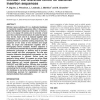59 search results - page 9 / 12 » Mutual Information Content of Homologous DNA Sequences |
CIKM
2009
Springer
13 years 11 months ago
2009
Springer
A suffix tree is a fundamental data structure for string searching algorithms. Unfortunately, when it comes to the use of suffix trees in real-life applications, the current metho...
NAR
2006
13 years 7 months ago
2006
ISfinder (www-is.biotoul.fr) is a dedicated database for bacterial insertion sequences (ISs). It has superseded the Stanford reference center. One of its functions is to assign IS...
ALMOB
2008
13 years 7 months ago
2008
The increasing throughput of sequencing raises growing needs for methods of sequence analysis and comparison on a genomic scale, notably, in connection with phylogenetic tree reco...
BMCBI
2006
13 years 7 months ago
2006
Background: Automatic annotation of sequenced eukaryotic genomes integrates a combination of methodologies such as ab-initio methods and alignment of homologous genes and/or prote...
BMCBI
2005
13 years 7 months ago
2005
Background: Expressed Sequence Tags (ESTs) are short and error-prone DNA sequences generated from the 5' and 3' ends of randomly selected cDNA clones. They provide an im...


